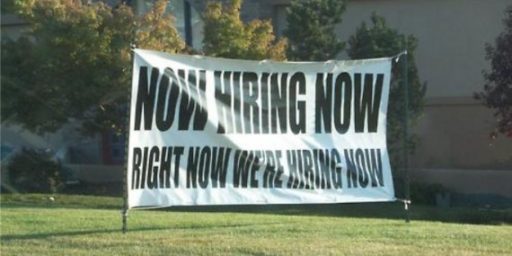A Strong May Jobs Report
The May Jobs Report seems to suggest that the first quarter dip in the economy was merely temporary:
Total nonfarm payroll employment increased by 280,000 in May, and the unemployment rate was essentially unchanged at 5.5 percent, the U.S. Bureau of Labor Statistics reported today. Job gains occurred in professional and business services, leisure and hospitality, and health care. Mining employment continued to decline.
In May, both the unemployment rate (5.5 percent) and the number of unemployed persons (8.7 million) were essentially unchanged. Both measures have shown little movement since February.
Among the major worker groups, the unemployment rates for adult men (5.0 percent), adult women (5.0 percent), teenagers (17.9 percent), whites (4.7 percent), blacks (10.2 percent), Asians (4.1 percent), and Hispanics (6.7 percent) showed little or no change in May.
(…)
Total nonfarm payroll employment rose by 280,000 in May, compared with an average monthly gain of 251,000 over the prior 12 months. In May, job gains occurred in professional and business services, leisure and hospitality, and health care. Employment in mining continued to decline.
(…)
The average workweek for all employees on private nonfarm payrolls remained at 34.5 hours in May. The manufacturing workweek was unchanged at 40.7 hours, and factory overtime remained at 3.3 hours. The average workweek for production and nonsupervisory employees on private nonfarm payrolls edged up by 0.1 hour to 33.7 hours.
In May, average hourly earnings for all employees on private nonfarm payrolls rose by 8 cents to $24.96. Over the year, average hourly earnings have risen by 2.3 percent. Average hourly earnings of private-sector production and nonsupervisory employees rose by 6 cents to $20.97 in May.
The change in total nonfarm payroll employment for March was revised from +85,000 to +119,000, and the change for April was revised from +223,000 to +221,000. With these revisions, employment gains in March and April combined were 32,000 more than previously reported. Over the past 3 months, job gains have averaged 207,000 per month.
The New York Times seems this as good news:
Blunting worries about the American economy’s momentum after a stretch of lackluster growth this year, the government reported on Friday that employers added a hefty 280,000 jobs in May, well above the average monthly totals logged over the last year.
The official unemployment rate ticked up to 5.5 percent, as more Americans returned to the labor force and returned to actively looking for work. At the same time, hourly wages rose 0.3 percent last month, finally providing workers with some long-awaited gains.
United States markets opened lower on concerns that the strong report would provide further reason for the Federal Reserve to raise short-term interest rates later this year from their near zero level.
Although the report provides just a snapshot of the economy and is subject to revision, analysts are looking at this freshest set of figures to help pierce the confusion over whether the economy’s contraction of 0.7 percent during the first quarter of 2015 was a blip, partly a casualty of the harsh winter, or evidence of a more fundamental slowdown.
“This is a confirmation that the economy is performing well and the first quarter was an aberration,” said Carl Tannenbaum, chief economist at Northern Trust.
He added that he was heartened by the growth in wages, which have now risen 2.3 percent over last year. “It’s good for workers and also a sign that capacity in the labor market is being utilized more fully.”
Although the recovery from the recession is now reaching its sixth anniversary, the gains have not been spread evenly, with the fortunes of some Americans rising while others languish. As a survey in October on families’ financial well-being by the Federal Reserve showed when it was released recently, nearly two-thirds of respondents said they were either “doing O.K.” or “living comfortably,” with the rest reporting they were “just getting by” or struggling.
“It’s a tale of two economies, the economy of the unskilled, and the economy of the semiskilled and the skilled,” said Robert A. Funk, chairman and chief executive of Express Employment Professionals, a staffing agency based in Oklahoma City that operates in 49 states.
There is pent-up demand for those with skills, like machinists, engineers and information and technology workers, he said, but those without that edge are continuing to have a tough time.
“We’re out here on Main Street, not Wall Street,” said Mr. Funk, former chairman of the Federal Reserve Bank of Kansas City. “We get a feel of medium and small companies and their attitudes. They are reticent to hire because they are not sure which way the economy is going to go.”
If nothing else, this may indicate that the second quarter was much better for the economy than the first three months of the year.






310,000 jobs and it’s warrants a quick take?
Your ODS is friggin’ killing you, isn’t it?
The lesson to draw from all this is that one month’s data is just that-one month’s data. Its not a trend. But that’s not too exciting though, so we try to make it more than what it is.
I’m beginning to wonder if our seasonable adjustments need some adjusting.
No doubt the many commenters who crowed giddily at the front page report on slowing will be along to acknowledge that they were wrong. If they can find this piece over here in the sidebar that is.
@Hal_10000: This year’s winter season was much harsher than previous years, on the east coast at least.
Related to the jobs issue and the economy is this Pacific Trade Treaty. Senator Warren, Sanders, and other leaders from both parties are against it. The Ameican people are being warned about it. The details and provisions of this treaty will be kept secret until after it is approved. Our congress members can see it – under security and are not allowed to tell the people what is in it ! Don’t believe it ? Try asking your congressional representatives for a copy ! We will not be able to read it until it is approved ! (Sound familiar ? “we will read it after we sign in” Pelosi)
If congress does not approve this treaty, watch for the president to use emergency powers to sign it, and he will go around congress by getting the Supreme Court to approve his actions. Some excuse will be given to the American people that the treaty is needed to keep the world economy stable.
All the pieces are in place and everything is coming together.
Yeah I see nothing good about that pacific trade deal. NAFTA murdered my home town and thousands of other towns like it.
There’s more going on with that deal then trade. Copyrights enforcement and more are involved which could create massive headaches for small timers trying to make it big.
From the NYT:
Or as Republicans might say, “Obama has destroyed the economy” and “the sky is falling.”